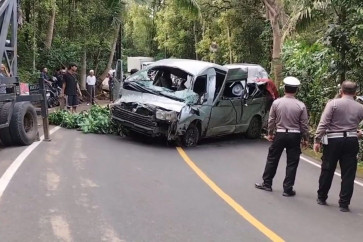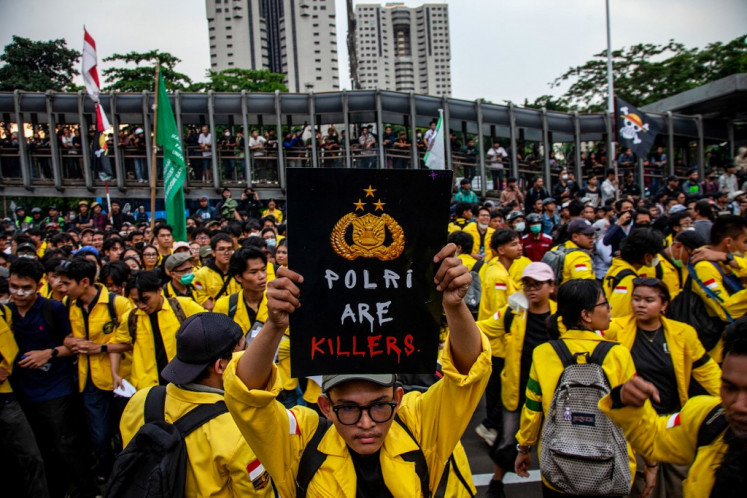Popular Reads
Top Results
Can't find what you're looking for?
View all search resultsPopular Reads
Top Results
Can't find what you're looking for?
View all search resultsIn Memoriam: PHOTOJOURNALIST OF TIANANMEN’S ICONIC TANKMAN PASSES AWAY IN BALI
Charlie Cole (1955-2019) (Photo courtesy of Robert Tonsing)American photojournalist Charlie Cole, whose career will always be associated with the iconic photograph of the Tankman, the Chinese office worker confronting a column of tanks during the 1989 Tiananmen Square bloodshed, died in Bali last week
Change text size
Gift Premium Articles
to Anyone
Charlie Cole (1955-2019) (Photo courtesy of Robert Tonsing)
American photojournalist Charlie Cole, whose career will always be associated with the iconic photograph of the Tankman, the Chinese office worker confronting a column of tanks during the 1989 Tiananmen Square bloodshed, died in Bali last week.
Cole, 64, a Bali resident of more than 15 years, was one of four cameramen who took the same shot with a telephoto lens from a Beijing hotel balcony, but his colleagues believe it was his tight framing of the event that won him the 1989 World Press Photo of the Year award.
However, sources familiar with the jury’s deliberations in New Delhi say it was a close call with Magnum photographer Stuart Franklin’s wider shot, including a burned-out bus in the background, originally preferred. It was only after a lunch break and revote that the award went to Cole.
Watching the man in a white shirt walk into the middle of Changan Avenue as the tanks approached, waving a jacket and shopping bag, Cole recalled: “I kept shooting in anticipation of what I felt was his certain doom. But to my amazement the lead tank stopped, then tried to move around him. But the young man cut it off again”.
Eventually, Public Security Bureau (PSB) agents intervened and hurried the man away. Even to this day, as the New York Times noted in a June 5 anniversary piece, his identity and fate is still not clear and the image remains largely blocked on the internet in China.
“I think his action captured peoples’ hearts everywhere and when the moment came, his character defined the moment, rather than the moment defining him,” Cole told the Times. “He made the image. I was just one of the photographers. And I felt honored to be there.”
Worried about security men searching his room, he wrapped the roll of film in plastic and attached it to the flush chain of a toilet tank. When they did come, they found his cameras, ripped the film out and left, seemingly satisfied they had neutralized the problem –– as Cole had intended.
Retrieved from its hiding place, the film was later developed at the Associated Press bureau and transmitted to Newsweek in time for deadline by a photo tech-photographer who had flown in from the magazine’s Tokyo office.
A decade earlier, employing similar subterfuge, New Zealand-born cameraman Derek Williams had smuggled the first film of the Russian invasion of Afghanistan out of Kabul in his underpants.
Cole always regretted that the Tankman image alone had become iconic of the Tiananmen tragedy, in the same way as the Saigon rooftop evacuation shot by Dutchman Hugh van Es became symbolic of the end of the Vietnam War in 1975.
Close friends never heard him breathe a word about the award because, in his view, it tended to overshadow the work and risks taken by other photographers during the crackdown against the demonstrators in the square that day.
Born in Bonham, Texas, talented, self-effacing and a life-long aficionado of barbecue, bourbon and the blues, Cole graduated in journalism from the University of Texas, Denton, north of Dallas, in 1978, his career in the news business already mapped out.
When his father, a chaplain in the United States Air Force, was posted in Japan, he moved back to Colorado Springs where he had grown up while the elder Cole was stationed at the nearby Paterson Air Base, the headquarters of the North American Aerospace Defense Command.
The contacts he developed through his father helped him with unique assignments over the years and gave him a deep knowledge of the US military, from its history to hardware and operations across the Pacific theatre.
Shortly after graduation, Cole parlayed stringing work for the Associated Press and United Press International into a full-time job for the Colorado Springs Sun newspaper, even then becoming a consistent National Press Photographers Association (NPPA) award winner.
In August 1980, he and close friend Steve Gardner flew to Japan, looking to establish themselves as freelancers in a region going through significant economic and political change. It was the last great era of old school journalism.
Then a journalism student at the University of Southern Mississippi, Gardner had met Cole five years earlier when the pair were working as staff photographers at the Ridgecrest Baptist Assembly Center in Black Mountain, North Carolina.
“Charlie was an excellent sports photographer in those days,” recalls Gardner, a photographer and recognized blues guitarist. “He had a great eye for the moment as well as planning his moves and making sure he was in the right place at the right time.” He was also a good darkroom technician.
Using joint photo exhibitions as a unique method of picking up work, they soon found that being English-speaking photographers working around Japan and Asia was their strongest point as they sought to break into the magazine market.
In 1983, they returned to the US to visit agents, develop contacts and to cover the 10th annual world reunion of the Hells Angels. “We hoped that our insider photos might help open doors on both sides of the Pacific,” Gardner says. “And it worked.”
The next two years they spent as specialist photographers traveling to military bases around Japan and the Pacific, an experience that drew Cole into a strong working relationship with Newsweek, which he maintained throughout his career.
He was in Manila for the 1985 Philippine people’s power uprising, which brought down then-president Ferdinand Marcos, and then moved to South Korea to cover the three years of often violent student demonstrations that led to the country’s transition into a democratic state.
Day after day, the world’s top photographers braved clouds of powerful teargas on the streets of Seoul, Kwangju and other Korean cities, the protests only tapering off as the political winds shifted in the lead up to the 1988 Seoul Olympic Games.
“He always reeked of tear gas, but he sure was fun to hang out with and he always knew where the action was going to be,”,” says British lensman Stephen Sweet, who recalls Cole scoring two Newsweek covers during that three-year period, the prelude to similar achievements in China, Afghanistan, Iraq and elsewhere.
Cole’s news career came to an abrupt halt in the mid-1990s when his Harley Davidson struck an open car door as he rode through Tokyo. His left leg was shattered and for a long while it was touch and go whether it would have to be amputated.
He later moved from Tokyo to Jakarta and then on to Bali where he built a villa with his Indonesian wife, Rosanna, making a quiet living doing commercial photography. He was in constant pain and complications from his injuries appear to have eventually led to his death.

.img_assist_custom-780x619.jpg)








